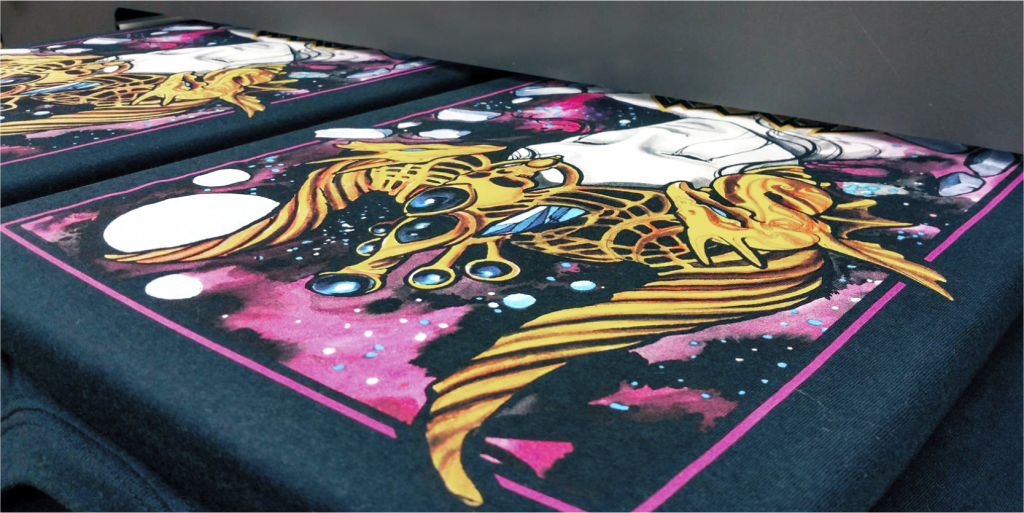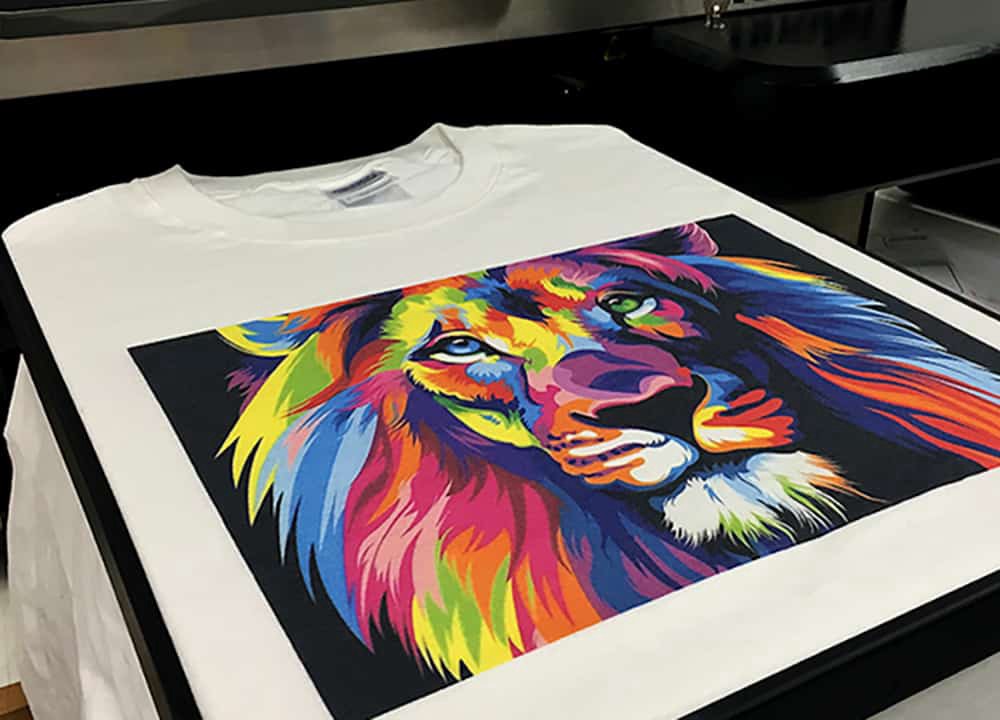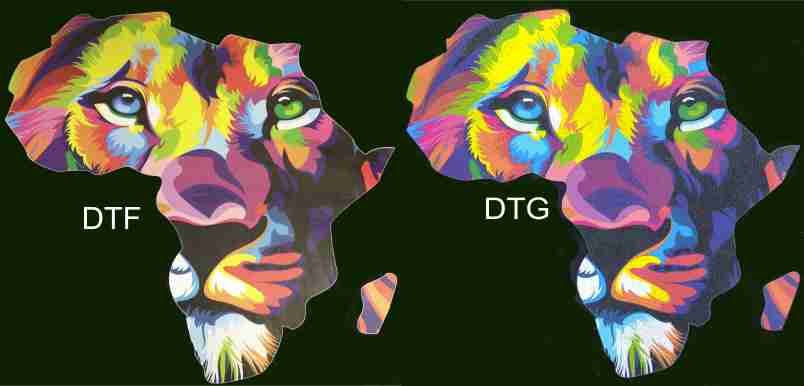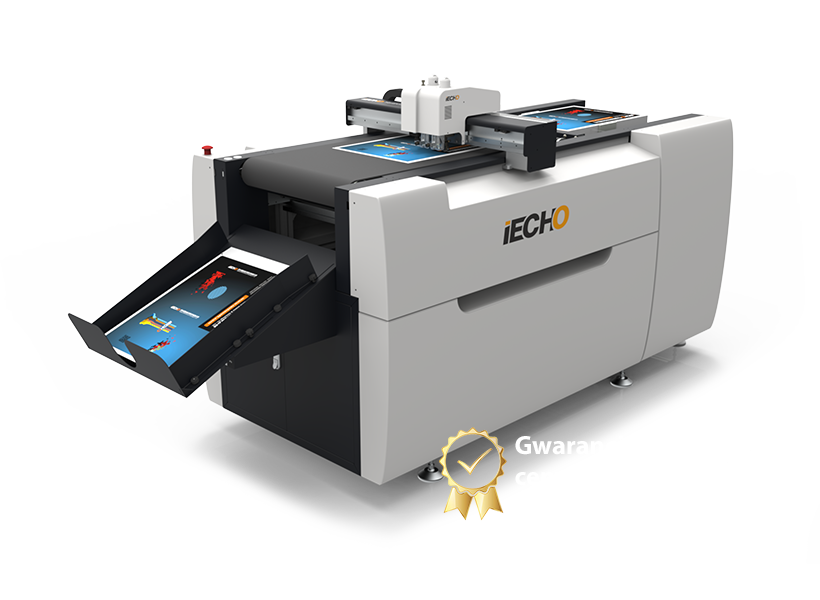DTG printing: what does direct to garment printing involve?
What is DTG printing and how does it work?
DTG (Direct to Garment) printing is a modern method of marking garments by directly applying a print to the fabric. This relatively new technology is revolutionizing the textile personalization market, offering high quality and versatility. Digital DTG involves the use of specialized printers adapted to print directly on garments, much like traditional inkjet printers print on paper.
In the DTG direct printing process, a special print head applies ink directly to the fabric fibers. DTG printing on clothing is made using digital technology, which allows for precise reproduction of even the most complex graphic designs with an accuracy of at least 300 DPI. This is a fundamental difference from traditional printing methods such as screen printing, where each color requires a separate stencil.

Direct DTG printing on garments involves several key steps:
- Preparation of graphic design in digital form
- Pretreatment of garments (pretreatment) - especially important for dark materials
- Apply an undercoat of white ink (for dark fabrics)
- Printing the right design in CMYK colors
- Fixing the print using a heat press or drying tunnel
Where will DTG printing work well? Materials and applications
DTG technology will work best on cotton or high cotton content materials. DTG printing on cotton T-shirts gives the best results because the natural cotton fibers absorb the ink perfectly, ensuring the durability and vivid colors of the print. Possibilities for using this marking method include:
- Cotton shirts and t-shirts
- Sweatshirts and sportswear
- Canvas bags
- Hats and textile accessories
- Interior design elements (pillowcases, curtains)
It is worth noting that while DTG printing works great on cotton, it can also be done on some polyester-blend fabrics, but with some limitations on color intensity and durability. For polyester fabrics, sublimation, another garment marking technique, is often a better choice.

Advantages of DTG printing
High quality and detail
One of the biggest advantages DTG printing is the ability to produce extremely detailed and colorful prints. Digital technology makes it possible to produce designs with smooth tonal transitions, shading and photographic image quality. Digital printing DTG offers great color reproduction, which is difficult to achieve with traditional printing methods.
Personalization and small print runs
DTG printing is cost-effective even for single garment pieces, making it ideal for:
- Custom clothing personalization
- Production of small design series
- Testing new designs before mass production
- Creating unique gifts
Unlike screen printing, which is only economical for larger runs, DTG allows personalization of single copies without high prepress costs.
Speed of execution
Direct DTG printing allows for fast turnaround, which is especially important for urgent orders. The entire process from design to finished product can be completed in a matter of hours, while traditional garment marking methods require much more preparation time.
Environmental friendliness
Compared to other printing techniques, DTG is relatively environmentally friendly. Mainly water-based inks are used, which contain fewer harmful chemicals than the inks used in screen printing. In addition, the process requires less water and generates less waste.
Limitations and disadvantages of DTG printing
Costs at high expense
Although DTG printing is economical for small runs, it can be less cost-effective than screen printing for larger runs. This is due to the cost of inks and the time it takes to produce each print.
Material limitations
As I mentioned earlier, the DTG method works best on cotton fabrics. Printing on fabrics with a high polyester content or synthetic fabrics may not be as durable and crisp. In addition, dark or colored fabrics require an additional primer of white ink, which increases the cost and lengthens the manufacturing process.
Durability of printing
Although DTG prints are quite durable, if proper washing rules are followed for printed garments, they may not be as durable as those made by screen printing or flock transfer. After many washes, gradual color fading is possible, especially if the garments are not properly cared for.
DTG printing vs. other garment marking methods
DTG vs screen printing
When comparing DTG printing with screen printing, the following differences are worth noting:
| Aspect | DTG printing | Screen printing |
|---|---|---|
| Small series | Very cost-effective | Hardly profitable |
| Large series | Less profitable | Very economical |
| Colors | Unlimited palette | Limited number of colors |
| Details | High level of detail | Less detail |
| Durability | Good | Very good |
| Preparation | Minimum | Time-consuming |
DTG vs. other digital techniques
There are also other methods of digital garment marking on the market, such as:
- Sublimation - ideal for polyester fabrics
- Digital transfer (reflect) - allows printing on various materials
- DTF (Direct to Film) printing - a relatively new technology that combines the advantages of DTG and transfers
Each of these techniques has its own unique advantages and limitations, so choosing the right method for marking garments should be tailored to the specific project, material and expected result.

Practical applications of DTG printing
Fashion and custom clothing
DTG printing has found widespread use in the fashion industry, especially in the segment of personalized clothing and small design runs. It allows designers to create unique designs without ordering large runs.
Promotion and marketing
Companies are increasingly using direct DTG printing to create:
- Corporate clothing
- Promotional gadgets
- Materials for events and trade fairs
- Limited edition advertising products
E-commerce and print on demand
One of the fastest growing printing applications DTG jest model biznesowy „print on demand”, gdzie produkty są drukowane dopiero po złożeniu zamówienia. Ten model działania umożliwia:
- Minimize inventory
- Elimination of risks associated with unsold inventory
- A wide range of designs without the need to maintain them physically
- Personalization of products according to customer preferences
How to choose the right DTG printer?
When choosing a printer for DTG printing, there are several key aspects to consider:
Equipment quality and experience
Guaranteed high quality printing depends largely on the quality of the equipment used. A professional printing house should have modern DTG printers and appropriate technological facilities.
Portfolio and samples
Before placing an order, it is a good idea to ask for samples of previous work or examples of work from a portfolio. This will allow you to assess the actual quality of prints and the experience of the printer.
Project handling
Good A printing company offering DTG printing services should provide comprehensive Project operation, including:
- Consultation on the preparation of graphics
- Advice on choosing the right materials
- Care tips for printed garments
FAQ - Frequently Asked Questions
How much does DTG printing cost?
Cena druku DTG zależy od kilku czynników: rozmiaru nadruku, liczby kolorów, typu materiału i nakładu. Przy pojedynczych sztukach koszt może wynosić od 15-50 zł za nadruk, przy większych seriach cena jednostkowa spada.
How long does a DTG print last?
Przy odpowiedniej pielęgnacji nadruk DTG może wytrzymać 30-50 prań. Kluczowe jest pranie w niskiej temperaturze (max 30°C), unikanie wybielaczy i suszenie na lewej stronie.
Can DTG-printed garments be washed in the washing machine?
Tak, ale należy przestrzegać kilku zasad: prać w temperaturze maksymalnie 30°C, wykręcić koszulkę na lewą stronę, używać delikatnych detergentów i unikać wybielaczy.
What is the minimum resolution of graphics for DTG printing?
Zalecana rozdzielczość to minimum 300 DPI w rzeczywistym rozmiarze nadruku. Dla najlepszych rezultatów warto przygotować grafikę w formacie PNG lub PDF z wysoką jakością.
On which materials does DTG printing work best?
Najlepsze rezultaty uzyskuje się na 100% bawełnie lub tkaninach z zawartością bawełny minimum 80%. Im wyższa zawartość bawełny, tym lepsze chłonięcie tuszu i trwałość nadruku.
Is DTG printing safe for children?
Tak, atramenty używane w druku DTG są certyfikowane i bezpieczne dla skóry. Wiele firm wykorzystuje atramenty z certyfikatem Oeko-Tex, co gwarantuje bezpieczeństwo dla najmłodszych.
How long does it take to complete a DTG order?
Standardowy czas realizacji to 2-5 dni roboczych. W przypadku pilnych zamówień możliwa jest ekspresowa realizacja w ciągu 24 godzin (za dodatkową opłatą).
Can DTG printing be done on colored clothing?
Tak, ale na ciemnych lub kolorowych tkaninach wymagany jest biały podkład (underbase), co może wpłynąć na końcowy efekt kolorystyczny i zwiększyć koszt.
How to prepare graphics for DTG printing?
Grafika powinna być w formacie wektorowym (AI, EPS) lub rastowym o wysokiej rozdzielczości (PNG, TIFF). Kolory należy przygotować w palecie CMYK, a rozmiar grafiki powinien odpowiadać rzeczywistemu rozmiarowi nadruku.
Is DTG printing suitable for photos?
Tak, druk DTG doskonale sprawdza się przy reprodukcji zdjęć dzięki wysokiej rozdzielczości i możliwości odwzorowania płynnych przejść tonalnych.
DTG printing trends 2025
Sustainability - green printing
Coraz większy nacisk kładzie się na wykorzystanie ekologicznych atramentów i materiałów. Drukarnie inwestują w atramenty na bazie wody i certyfikowane materiały organiczne.
Mass customization
Rozwój technologii pozwala na jeszcze szybszą personalizację produktów, co wspiera trend „mass customization” – masowej personalizacji.
Integration with AI
Sztuczna inteligencja wspomaga proces przygotowania grafik, optymalizacji kolorów i automatyzacji procesu druku.
Print on Demand (Print)
Model POD zyskuje na popularności, szczególnie w e-commerce, pozwalając na oferowanie szerokiej gamy produktów bez konieczności magazynowania.
DTG Glossary
DPI (Dots Per Inch) – liczba punktów na cal, miara rozdzielczości druku
Pretreatment – wstępna obróbka tkaniny przed drukiem, poprawia przyczepność tuszu
CMYK – model kolorów używany w druku (Cyan, Magenta, Yellow, Key/Black)
Underbase – biały podkład nanoszony pod właściwy nadruk na ciemnych tkaninach
Curing – proces utrwalania nadruku przy użyciu wysokiej temperatury
RIP Software – oprogramowanie przetwarzające dane graficzne na sygnały dla drukarki
Wash Test – test trwałości nadruku po określonej liczbie prań
Color Fastness – odporność kolorów na blaknięcie
Care of DTG-printed garments
Laundry rules:
- Temperatura maksymalnie 30°C
- Wykręcanie na lewą stronę
- Unikanie wybielaczy i zmiękczaczy
- Delikatne detergenty bez fosforanów
- Drying in a shady place
Ironing:
- Prasować na lewej stronie lub przez bibułkę
- Temperatura żelazka maksymalnie 150°C
- Unikać prasowania bezpośrednio na nadruku
Business with DTG printing
Print on Demand business model
- Brak konieczności magazynowania
- Niskie koszty rozpoczęcia działalności
- A wide range of risk-free offerings
- Process automation
POD Business Tools:
- E-commerce platforms (Shopify, WooCommerce).
- Integrations with printing houses (Printful, Gooten)
- Narzędzia projektowe (Canva, Adobe Creative Suite)
- Systemy zarządzania zamówieniami
Cost comparison of different printing methods
| Method | 1-10 pcs. | 11-50 pcs. | 51-100 pcs. | 100+ pcs. |
|---|---|---|---|---|
| DTG | Best | Good | Acceptable | Dear |
| Screen printing | Very expensive | Dear | Good | Best |
| Transfer | Good | Good | Acceptable | Dear |
| Sublimation | Good | Good | Good | Good |
Summary
DTG printing is a modern and versatile garment marking method that has revolutionized the textile personalization market. With its high quality, ability to produce detailed, multi-color prints and cost-effectiveness for small runs, this technology is an excellent alternative to traditional garment printing methods.
Chociaż druk bezpośredni DTG ma pewne ograniczenia, szczególnie w zakresie trwałości i rodzajów obsługiwanych materiałów, jego zalety sprawiają, że jest coraz chętniej wybierany przez projektantów, firmy i osoby poszukujące unikalnej, personalizowanej odzieży. Z pewnością, wraz z rozwojem technologii drukarek i atramentów, druk DTG będzie zyskiwał na popularność, oferując jeszcze lepszą jakość i większe możliwości kreatywne.
Kluczem do sukcesu w druku DTG jest wybór odpowiedniej drukarni, właściwe przygotowanie grafiki i znajomość ograczeń tej technologii. Dzięki temu można w pełni wykorzystać potencjał tej innowacyjnej metody znakowania odzieży.

